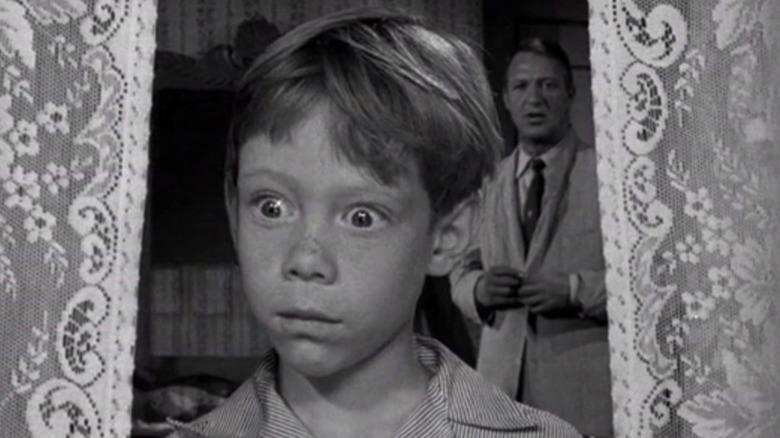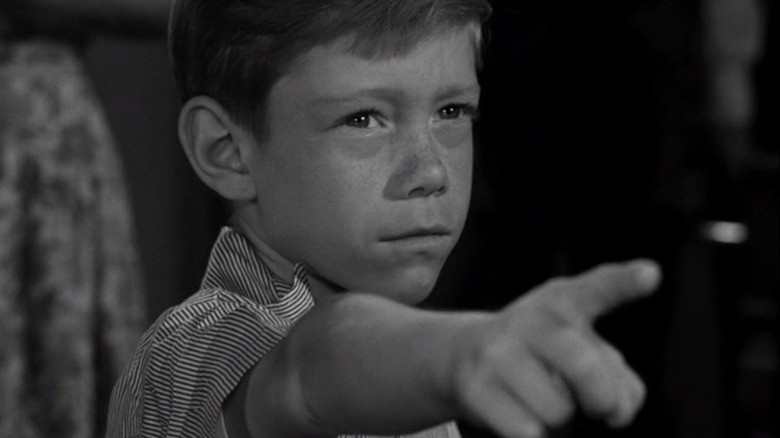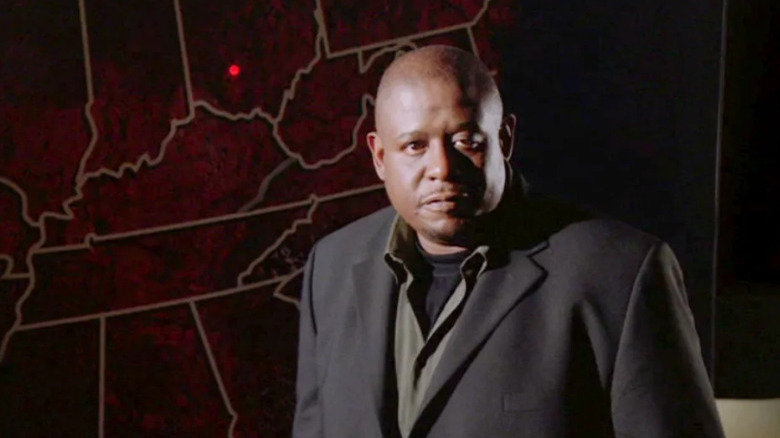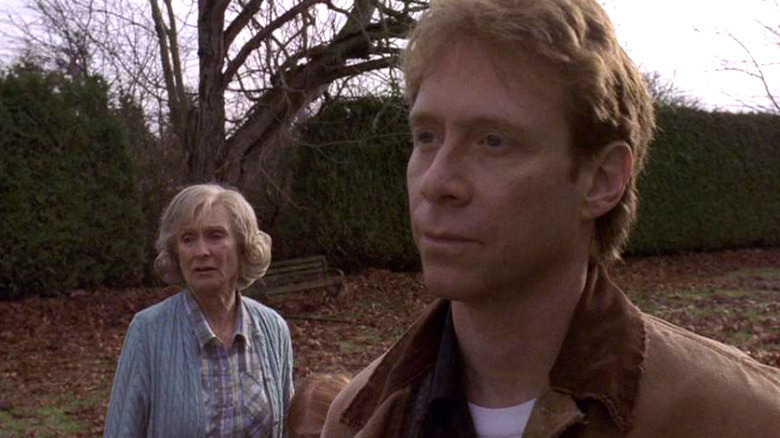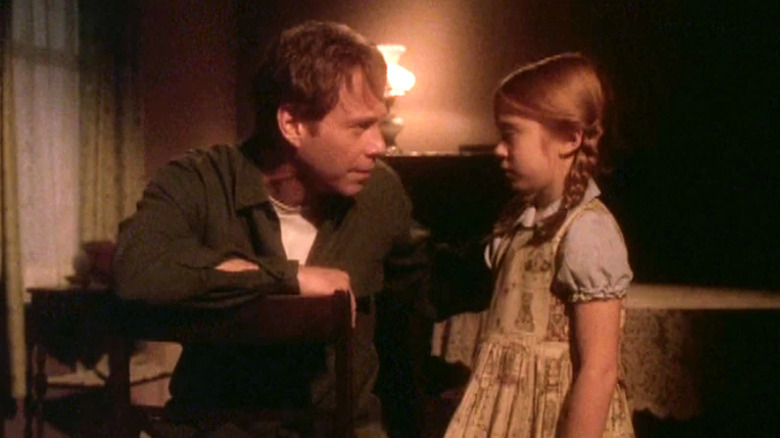The Scariest Episode Of The Twilight Zone Had A Sequel
You never knew exactly what you would get when "The Twilight Zone" began. The series — produced and largely written by celebrated Emmy-winning writer Rod Serling — was a loose collection of fantastical tales. Some were supernatural, some were science fiction. Some were comedies, and some were scary as hell.
It should come as little surprise that the "scary as hell" episodes are among the most memorable installments of the series. William Shatner's desperate screaming that there's a man on the wing of the plane in "Nightmare at 20,000 Feet" was instantly iconic, and repeatedly remade. Agnes Moorehead silently fighting off an invading force of tiny homicidal aliens in "The Invaders" was strange and shocking, and seemingly set the stage for future "tiny monster" horror movies like "Don't Be Afraid of the Dark" and "Gremlins."
But perhaps no "Twilight Zone" episode is more overwhelmingly terrifying than the one about a little kid with godlike powers. "It's a Good Life" imagines a life where the world has vanished, and the only town left is Peaksville, Ohio. That's the home of Anthony Fremont (Billy Mumy), a six-year-old who can control reality with his mind and spends his time lighting adults on fire, transforming them into human jack-in-the-boxes, and wishing anything he doesn't like into "the cornfield."
It's a story that's been remade, ripped off, and parodied many times, but what a lot of people forget is that "It's a Good Life" was not the end of Anthony Fremont's story. Unlike any other "Twilight Zone" episode, this classic story has a proper, canonical sequel which, sadly, has fallen through the cracks of popular culture.
'It's a good episode, Anthony ... it's REAL good'
Billy Mumy was one of the most recognizable child stars of his era, thanks largely to his co-starring role on the hit TV series "Lost in Space." While it's fair to say that Mumy never had a role quite that prominent again in the decades that followed, he's a hard-working actor who has, as Joel Hodgson pointed out in "Mystery Science Theater 3000," kept himself very busy. In addition to co-starring in the entire series of the cult classic sci-fi series "Babylon 5," he was also half of the musical act Barnes & Barnes, whose novelty song "Fish Heads" is one of the most bizarre and earwormy hits of the 1980s. (Did you know Bill Paxton directed the very bizarre music video for "Fish Heads?" Well, now you do.)
But although Bill Mumy moved on quite successfully from his stint on "The Twilight Zone," he also never forgot his iconic character. "I've always liked Anthony, and I've kept Anthony with me. I'll send people to the cornfield when I'm really pissed at them. I mean, I'll do it," Bill Mumy ominously revealed in The Twilight Zone Companion. "Not that it works, but it's a release for me."
Rod Serling didn't forget either: He tried to turn "It's a Good Life" into a feature film. After that fell through, it got remade by Joe Dante as a hallucinogenic installment in "Twilight Zone: The Movie," and later parodied by "The Simpsons" in the second "Treehouse of Horror" Halloween special. By the time the sequel was produced in 2003, the episode's reputation had been cemented and it should have been a pretty big deal that Bill Mumy was returning to play his classic, sinister role.
The only problem was the sequel aired on UPN, so hardly anybody has even heard about it, let alone watched it.
The trouble with UPN
UPN was a network that debuted in 1995 and existed until 2006, when it merged with "The WB" to become "The CW," which still exists today. For years UPN was best known as the only channel with new episodes of "Star Trek," but they did have a few beloved shows in their lineup, like "Veronica Mars," "Home Movies," and "Moesha." Then again they also produced one of the most notorious duds in TV history, "The Secret Diary of Desmond Pfeiffer," and many other, understandably forgotten programs like "The Love Boat: The Next Wave."
While we're on the subject of forgotten UPN reboots of old TV shows, the third iteration of "The Twilight Zone" aired somewhat unnoticeably on the network for 43 episodes, from 2002-2003. Hosted by future Academy Award-winner Forest Whitaker, the series featured new tales starring big names of the era. This version of "The Twilight Zone" was under a network mandate to feature contemporary musicians like Usher and Jessica Simpson, and also featured new and future stars Katherine Heigl, Joshua Jackson, Linda Cardellini, and many others.
Many of these UPN episodes of "The Twilight Zone" were brand-new tales, but a few classic episodes were remade as well. "Eye of the Beholder" and "Monsters Are Due on Maple Street" were both brought into the 21st century, but the makers of the new series didn't settle for merely remaking "It's a Good Life." They not only wrote a sequel to the original episode, they brought back the original cast, with Mumy reprising the horrifying role of Anthony Fremont, and Cloris Leachman reprising her role as Agnes, Anthony's horrified mother.
The Mumy returns
"It's Still a Good Life" returns to Peaksville decades later, where we discover Anthony has grown up and is as much of a monster as ever. The townsfolk are still terrified of him, and just like in the original episode, they are forced to constantly think happy thoughts and praise Anthony's every decision — even the ones that terrify and mutilate them — because he can read all their minds.
Only one thing has changed: Anthony has a daughter of his own, Audrey, played by the star's real-life daughter, Liliana Mumy. Anthony dotes on Audrey and, when another child pushes her out of a tree, decides not to kill the child because she asks him not to. He sets the boy's father on fire instead. Agnes tries to teach Audrey the values she was never able to teach Anthony because his childish tantrums had deadly consequences, but when it turns out Audrey inherited her father's abilities and can bring things back from the cornfield — something Anthony was never able to do — Agnes realizes she has an opportunity to stop her son's reign of terror once and for all.
The problem is that Audrey is still a child, no matter how well-mannered she is. So even though she thinks her father was wrong to send the rest of the world into the cornfield, she also loves him. When Agnes tries to get Audrey to destroy her own father, Audrey instead turns on Agnes and the rest of the town and sends them away forever. This horrifies Anthony, who may have lived in a constant state of paranoia and insecurity because he wasn't sure if anyone really loved him, but he still didn't want to be lonely and bored.
The episode ends with Audrey bringing back the rest of the world — except, apparently, the residents of Peaksville — thus giving the all-powerful Fremonts a whole new playground.
On becoming a god in Peaksville, Ohio
"It's a Good Life," originally based on a short story by Jerome Bixby, is still a terrifying tale. The horrifying imagery of the human jack-in-the-box and the vague, but evocative threat of being "sent to the cornfield" are grotesque and nightmarish, but there's more to it than that. The idea of a child who cannot be disciplined or even reasoned with, whose every whim must be catered to or else everyone in civilization will suffer, isn't just scary from a parental point of view. It also speaks to any society led — justly or otherwise — by immature, dangerous tyrants who make unreasonable demands of the people, who suffer in silent fear. This, sadly, still has real-world ramifications. The episode has aged very well.
The sequel doesn't have quite the same heft and instead focuses primarily on giving Anthony's victims (and the audience) hope for a happy, or at least satisfying resolution, and then tearing that all away. The most horrifying elements of "It's Still a Good Life" are Leachman's pained performance when she realizes that, although Audrey fell from a tree at the beginning of the episode, she hasn't fallen far from the proverbial tree, but also the shocking, implied nightmare of Audrey's mother. It's hard to imagine anyone falling naturally in love with Anthony, and since we know she was wished into the cornfield after Audrey was born, we know she absolutely didn't. The implications are harrowing and ghoulish. We won't dwell on them here.
So "It's Still a Good Life" is a disturbing follow-up, even though it's not as powerful as the original "Twilight Zone" episode. It's certainly worth watching for any fan of the series, and at the very least, it doesn't deserve to be sent to the cornfield.
